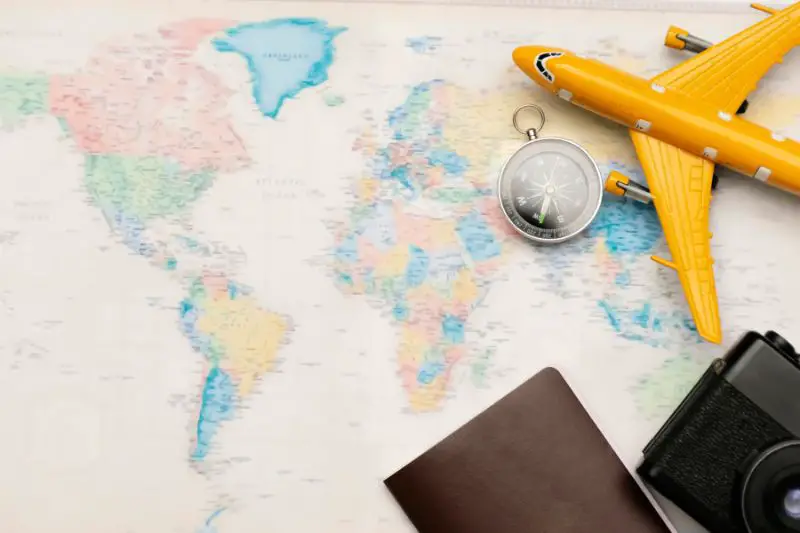Have you ever wondered why some travel ads feel like they were made just for you? That’s not a coincidence—it’s the power of tourism market segmentation at work. In a world where travelers have vastly different needs, interests, and budgets, a one-size-fits-all approach simply doesn’t cut it.
Tourism businesses that truly understand their audience don’t just attract more visitors—they create experiences that keep travelers coming back. Whether it’s a luxury resort catering to high-end vacationers or a budget airline appealing to backpackers, successful companies know exactly who they’re targeting and how to reach them.
In this article, we’ll break down what tourism market segmentation is, why it’s essential, and how businesses can use it to connect with the right travelers. Get ready to discover the strategies that make tourism marketing more effective and engaging.
What Is Tourism Market Segmentation?

Understanding tourism market segmentation is essential for businesses looking to attract the right travelers. Instead of using broad, generic marketing strategies, segmentation allows tourism brands to tailor their approach based on specific traveler characteristics. This leads to more effective campaigns, higher customer satisfaction, and increased profitability.
Defining Tourism Market Segmentation
Tourism market segmentation is the process of dividing a diverse audience of travelers into smaller, more defined groups based on shared characteristics. These characteristics can be demographic, geographic, psychographic, or behavioral. By understanding these differences, businesses can develop personalized marketing messages, targeted promotions, and specialized services to meet the unique needs of each segment.
For example, a beachfront resort targeting luxury travelers will use different messaging and advertising channels than a hostel catering to budget-conscious backpackers. Each segment requires a different marketing strategy to be effectively reached and engaged.
Why Market Segmentation Matters in Tourism
Market segmentation is more than just a marketing technique—it’s a strategic approach that shapes how tourism businesses attract, retain, and serve their customers. Here’s why it’s crucial:
- Increased Marketing Efficiency – By focusing on specific traveler groups, businesses can allocate their marketing budget more effectively and reduce wasted efforts.
- Better Customer Experience – Travelers receive personalized offers and services that align with their preferences, increasing satisfaction and loyalty.
- Higher Conversion Rates – When marketing messages speak directly to a traveler’s needs, they are more likely to book a trip or service.
- Competitive Advantage – Understanding customer segments helps businesses differentiate themselves and offer unique value propositions.
Real-World Example of Market Segmentation in Tourism
Consider the case of Airbnb. The platform successfully segments its market by catering to different types of travelers—families looking for spacious vacation homes, solo travelers seeking budget-friendly stays, and business professionals needing short-term rentals. By using targeted marketing for each segment, Airbnb ensures that its messaging resonates with the right audience, increasing bookings and customer satisfaction.
Tourism market segmentation is a powerful tool for businesses looking to refine their marketing approach. In the next section, we’ll explore the key types of segmentation and how they shape the travel industry.
The Main Types of Tourism Market Segmentation
Tourism businesses cannot effectively market their services without understanding the diverse needs of travelers. Market segmentation helps them identify and categorize potential customers based on key characteristics. By using different segmentation methods, businesses can develop more targeted marketing strategies, ensuring they reach the right audience with the right message.
Demographic Segmentation
Demographic segmentation divides travelers based on measurable characteristics such as age, gender, income level, education, and family status. These factors influence travel preferences, spending habits, and decision-making processes.
For example, luxury resorts often target high-income individuals or couples seeking exclusive experiences, while budget airlines cater to younger travelers or students looking for affordable travel options. A 2023 study by Skift found that millennials and Gen Z travelers prioritize experiences over material goods, making them more likely to seek adventure or cultural travel.
Geographic Segmentation
Geographic segmentation categorizes travelers based on their location, including country, region, or even climate. Understanding where travelers come from allows businesses to tailor their offerings based on cultural expectations and travel behaviors.
For instance, a ski resort in Canada may focus its winter marketing campaigns on tourists from warm-climate regions who are eager to experience snow-based activities. Similarly, European travel agencies often promote summer destinations to Northern European tourists looking to escape colder weather.
Psychographic Segmentation
Psychographic segmentation considers lifestyle, values, personality, and interests. This approach helps businesses connect with travelers on a deeper level by aligning their offerings with personal motivations and travel styles.
For example, eco-tourism companies target environmentally conscious travelers who seek sustainable and responsible travel experiences. Meanwhile, wellness retreats appeal to individuals who prioritize health, mindfulness, and relaxation. According to a Global Wellness Institute report, wellness tourism was valued at $814 billion in 2022, highlighting the demand for travel experiences focused on well-being.
Behavioral Segmentation
Behavioral segmentation focuses on how travelers interact with tourism products and services. This includes factors such as booking patterns, brand loyalty, travel frequency, and spending habits. Businesses analyze this data to offer personalized experiences and promotions.
Loyalty programs, such as those offered by major hotel chains and airlines, rely on behavioral segmentation to reward repeat customers. A traveler who frequently books luxury accommodations will receive different promotions than someone who primarily chooses budget-friendly options.
Purpose-Based Segmentation
Travelers often choose destinations and services based on their trip’s purpose. Purpose-based segmentation divides tourists into categories such as:
- Leisure travelers – Individuals or families traveling for relaxation, entertainment, or cultural experiences.
- Business travelers – Professionals traveling for work-related reasons, often requiring convenience, efficiency, and corporate-friendly amenities.
- Adventure tourists – Thrill-seekers looking for activities such as hiking, scuba diving, or extreme sports.
- Medical tourists – Patients traveling abroad for specialized healthcare treatments, a market projected to grow to $180 billion by 2026, according to the Medical Tourism Association.
- Religious travelers – Pilgrims visiting sacred sites, such as Mecca for Hajj or the Vatican for Catholic devotees.
Each of these segments requires a different marketing approach, from targeted advertisements to customized travel packages.
Understanding these types of tourism market segmentation allows businesses to refine their marketing efforts, optimize customer engagement, and drive growth.
The Benefits of Tourism Market Segmentation
Implementing market segmentation in tourism is not just a marketing strategy—it’s a business necessity. By understanding and catering to specific traveler groups, tourism businesses can enhance customer satisfaction, maximize revenue, and improve operational efficiency. Here’s how segmentation delivers tangible benefits.
Enhanced Marketing Effectiveness
One of the primary advantages of market segmentation is the ability to create highly targeted marketing campaigns. Instead of using a broad, generic message, businesses can tailor advertisements, promotions, and content to resonate with a specific audience.
For example, a luxury cruise line targeting retirees will use a different tone and imagery than a backpacker hostel appealing to young travelers. By focusing on the right audience, businesses can increase engagement and conversion rates while reducing wasted marketing spend.
Increased Customer Satisfaction and Loyalty
Travelers are more likely to return to a brand that understands their needs and preferences. By offering personalized services and experiences, tourism businesses can foster loyalty and encourage repeat bookings.
A prime example is Marriott Bonvoy’s loyalty program, which segments customers based on travel frequency, spending habits, and preferred destinations. By providing tailored rewards and exclusive deals, Marriott strengthens customer relationships and encourages long-term brand loyalty.
Optimized Pricing Strategies
Segmentation allows businesses to adjust pricing strategies based on different traveler groups. This is particularly useful for airlines, hotels, and travel agencies that cater to both budget-conscious travelers and high-end clients.
For instance, budget airlines like Ryanair and Southwest attract price-sensitive travelers with low base fares while offering add-ons such as priority boarding and extra baggage fees. Luxury resorts, on the other hand, focus on premium pricing strategies, emphasizing exclusivity and personalized experiences.
Better Resource Allocation
By knowing which segments generate the most revenue and engagement, tourism businesses can allocate resources more efficiently. This ensures that marketing budgets, staffing, and service offerings are aligned with the most profitable customer groups.
A ski resort, for example, may find that families make up the majority of its visitors during winter, while adventure travelers dominate the off-season. By adjusting marketing efforts and operational priorities accordingly, the resort can maximize occupancy rates year-round.
Competitive Advantage
Understanding traveler segmentation helps businesses stand out in a crowded market. Companies that effectively differentiate themselves by catering to specific niches can build stronger brand identities and attract loyal customers.
Take the example of G Adventures, a travel company specializing in small-group adventure tours. By targeting eco-conscious and experience-driven travelers, the company has built a reputation for sustainable tourism and unique cultural immersion, setting itself apart from traditional tour operators.
Higher Profitability
Ultimately, market segmentation leads to increased profitability by attracting the right customers and delivering services that match their expectations. When businesses align their offerings with traveler preferences, they reduce inefficiencies and boost overall revenue.
A 2023 report by the World Travel & Tourism Council (WTTC) found that businesses using data-driven segmentation strategies saw an average revenue increase of 20% compared to those with generic marketing approaches. This demonstrates the significant financial impact of understanding and applying market segmentation principles.
Implementing Tourism Market Segmentation Strategies
Effectively applying market segmentation strategies can help tourism businesses refine their marketing, improve customer experiences, and maximize profitability. A well-structured approach ensures that resources are allocated efficiently and messaging resonates with the right audience.
Conducting Market Research
Understanding your target audience begins with thorough market research. Businesses should gather data through:
- Surveys and Questionnaires – Direct feedback from travelers provides valuable insights into preferences, expectations, and spending habits.
- Website and Social Media Analytics – Tracking online behavior helps identify customer interests and engagement patterns.
- Industry Reports and Competitor Analysis – Studying market trends and competitors’ strategies reveals opportunities for differentiation.
For example, a travel agency specializing in eco-tourism might conduct surveys to determine whether travelers prioritize sustainability certifications, local experiences, or luxury eco-lodges.
Defining Customer Segments
Once data is collected, businesses should categorize travelers based on relevant segmentation criteria such as demographics, geography, psychographics, or behavior. Clearly defined segments allow for targeted marketing efforts.
For instance, a hotel chain may identify three primary customer segments: business travelers, family vacationers, and solo adventurers. Each group has distinct needs, from high-speed Wi-Fi and conference rooms to kid-friendly amenities and guided tours.
Tailoring Marketing Strategies
Personalized marketing is key to engaging different traveler segments effectively. Businesses should adapt their messaging, channels, and promotional offers to match audience preferences.
- Content Marketing – Blog posts, videos, and social media campaigns should highlight aspects that appeal to specific segments. A luxury resort may create video tours showcasing exclusive spa treatments, while an adventure travel company shares customer testimonials from extreme sports experiences.
- Email Campaigns and Retargeting Ads – Personalized emails and targeted ads can encourage repeat bookings. For example, airlines often send special offers to frequent flyers based on past travel history.
- Local Partnerships and Influencer Marketing – Collaborating with travel influencers and local businesses helps attract niche audiences. A boutique hotel may partner with wellness influencers to promote yoga retreats.
Enhancing Customer Experience
Market segmentation also enables businesses to refine their offerings and customer service strategies. By aligning services with customer expectations, businesses can increase satisfaction and loyalty.
- Customized Packages and Loyalty Programs – Tour operators can create specialized packages for honeymooners, adventure seekers, or retirees. Similarly, hotels can offer loyalty programs with tailored perks, such as free spa sessions for wellness travelers.
- Personalized Communication – Using CRM tools to track guest preferences ensures a seamless experience. For example, a returning guest at a luxury hotel may appreciate being greeted with their preferred drink upon arrival.
Measuring and Adjusting Strategies
Implementing segmentation is an ongoing process that requires regular evaluation. Businesses should track key performance indicators (KPIs) such as:
- Booking Trends and Revenue Growth – Analyzing which segments contribute the most to sales helps refine targeting efforts.
- Customer Satisfaction and Retention Rates – Positive reviews and repeat bookings indicate whether segmentation strategies are effective.
- Campaign Engagement Metrics – Monitoring click-through rates, conversion rates, and ad performance ensures marketing efforts yield results.
If a travel agency notices declining engagement from a specific segment, they can adjust messaging, offer new incentives, or explore additional marketing channels.
Case Studies: Successful Tourism Market Segmentation

Examining real-world examples of effective market segmentation in the tourism industry provides valuable insights into best practices. These case studies highlight how different businesses have leveraged segmentation to improve marketing strategies, enhance customer experiences, and drive revenue growth.
Luxury Travel: Four Seasons Hotels & Resorts
Four Seasons Hotels & Resorts is a prime example of successful segmentation in the luxury travel sector. The brand targets high-net-worth individuals, business travelers, and affluent families by offering:
- Personalized luxury experiences – From private butlers to exclusive city tours, the brand tailors services to each guest’s preferences.
- Loyalty programs for repeat guests – The Four Seasons Preferred Partner program rewards frequent visitors with exclusive benefits, enhancing customer retention.
- Targeted digital marketing – The company utilizes data-driven insights to deliver personalized content, such as vacation recommendations and special promotions.
By focusing on these distinct traveler segments, Four Seasons has maintained a strong brand identity and customer loyalty in the competitive luxury hospitality market.
Adventure Tourism: G Adventures
G Adventures, a leading small-group travel company, effectively segments its audience based on travel preferences, age groups, and activity levels. Key segmentation strategies include:
- Themed tours for niche markets – Offering trips for solo travelers, families, and students allows the company to cater to different demographics.
- Sustainability-focused travelers – By promoting eco-conscious tourism and local community engagement, G Adventures attracts environmentally responsible travelers.
- Targeted storytelling and influencer marketing – The company shares real customer experiences and collaborates with travel influencers to appeal to adventure-seekers.
This segmentation approach has helped G Adventures grow a loyal customer base while positioning itself as a leader in responsible tourism.
Budget Travel: Airbnb
Airbnb disrupted the hospitality industry by catering to diverse traveler segments through a flexible and scalable business model. Key segmentation strategies include:
- Diverse accommodation options – From budget-friendly shared spaces to high-end luxury rentals, Airbnb offers choices for every budget.
- Experiential travel focus – The platform promotes unique local experiences, appealing to travelers looking for cultural immersion.
- Data-driven personalization – Airbnb uses AI and machine learning to suggest listings based on user preferences, booking history, and search behavior.
By segmenting its audience effectively, Airbnb continues to attract a wide range of travelers, from backpackers to luxury vacationers.
Destination Marketing: Visit Scotland
Visit Scotland, the country’s national tourism board, successfully segments its marketing efforts to attract various traveler types. Their strategies include:
- Targeted advertising for international travelers – Customized campaigns focus on key markets like North America, Europe, and Asia.
- Seasonal promotions – Visit Scotland promotes different travel experiences based on the time of year, such as winter sports in the Highlands or summer festivals in Edinburgh.
- Cultural and heritage tourism – Special campaigns highlight Scotland’s castles, whisky distilleries, and historic landmarks to attract history enthusiasts.
This data-driven segmentation approach has helped Scotland increase tourist arrivals and position itself as a year-round travel destination.
Conclusion
Tourism market segmentation is a powerful strategy that allows businesses to better understand their customers, tailor marketing efforts, and enhance the overall travel experience. By dividing the market into well-defined segments—whether based on demographics, behavior, psychographics, or geography—companies can create more relevant and effective campaigns that drive customer engagement and loyalty.
Real-world examples from industry leaders like Four Seasons, G Adventures, Airbnb, and Visit Scotland demonstrate how thoughtful segmentation can lead to increased revenue, brand differentiation, and long-term success. As the tourism industry continues to evolve, emerging trends such as AI-driven personalization, sustainability-focused travel, and the rise of experience-based tourism will shape the future of segmentation strategies.
To stay competitive, businesses must continuously refine their segmentation approaches, leverage data-driven insights, and adapt to shifting traveler preferences. By doing so, they can build stronger connections with their target audiences and create travel experiences that resonate on a deeper level.




